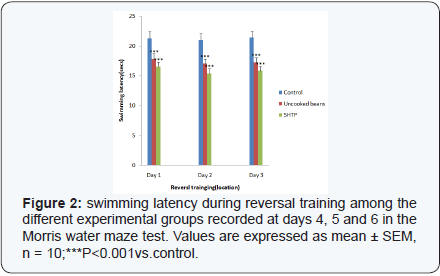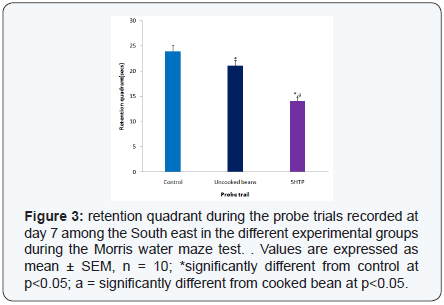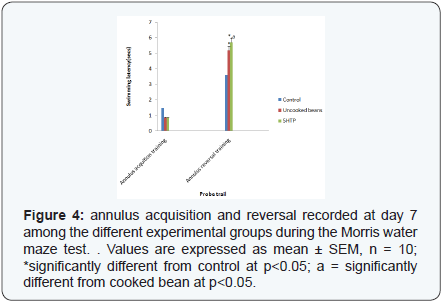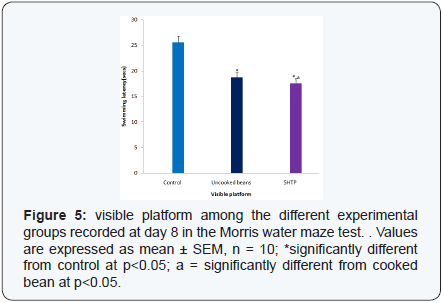Neurobehioural Effects of Chronic Consumption of Uncooked Black Eye Beans on Spatial Learning and Memory in Mice
Aduema W*
Department of Human Physiology, Gregory University, Nigeria
Submission: December 05, 2016; Published: December 15, 2016
*Corresponding author: Aduema W, Department of Human Physiology, Gregory University, Nigeria, Email: Wadioniaaduema@gmail.com
How to cite this article: Aduema W. Neurobehioural Effects of Chronic Consumption of Uncooked Black Eye Beans on Spatial Learning and Memory in 002 Mice. Curr Trends Biomedical Eng & Biosci. 2016; 1(2): 555556. DOI: 10.19080/CTBEB.2016.01.555556
Abstract
Beans, the stable diet of Nigerians contains serotonin and its precursor, 5-Hydroxytryptophan. Serotonin as a neurotransmitter has neurobehavioural actions which include mood, memory, learning and sleep. It was therefore the aim of this study to find out whether long term consumption of uncooked black eye beans (Vigna unguiculata) diet commonly called iron beans, has effects on some neurobehavioural parameters notably; learning and memory, using Swiss white mice as experimental animals. Thirty (30) CD1 mice weighing 18-30g were randomly assigned into three groups, viz; control, uncooked beans and serotonin precursor. They were fed normal rodent chow and 50% uncooked beans diet (w/w), while another set of mice were placed on serotonin precursor (5-HTP) diet (0.2mg/50g w/w) respectively for four weeks. All the mice had access to clean drinking water ad libitum. Before the neurobehavioural parameters were assessed, the phytochemical analysis of the beans, LD50 of the beans (Vigna unguiculata) and that of the serotonin precursor (5-HTP) were determined. Serotonin concentration was measured in the beans using gas chromatography analysis. Learning and memory, was investigated alongside food and water intake and body weight change. Mice were tested in the Morris water maze for 8 days: 3 days of acquisition training, 3 days of reversal training, 1 day of single probe trial and 1 day for visible platform task. Learning on days 1, 2 & 3 of acquisition training was improved in the uncooked beans and serotonin precursor diet-fed mice when compared to control (p<0.001, respectively). The trend was similar during the reversal training, memory was improved in the beans and serotonin precursor diet-fed mice when compared to control (p<0.001). During the probe trial, the swim duration in the South-East quadrant was significantly higher for uncooked beans and serotonin precursor group compared to control (p<0.05). However, during the visible platform task, the swim latencies for the uncooked beans and serotonin precursor group were significantly lower compared to control. In conclusion, long term consumption of uncooked beans diet enhances cognitive memory and can be therapeutically useful in retrograde amnesia.
Keywords: Serotonin, Beans, Morris water maze and Mice
Introduction
The black eyed pea or black eyed beans, a legume, is a subspecies of the cowpea, grown around the world for its medium-sized, edible bean. The bean mutates easily, giving rise to a number of varieties [1]. The common commercial one is called California black eye; it is pale-colour with a prominent black spot. The current accepted botanical name is vigna unguiculata subsp. Unguiculata, although previously it was classified in the genus Phaseolus.
The black-eye peas are actually a small, almost white beans with a black spot along their side originally brought to the United States by slave traders, this beans has been a popular food in the Southern US for hundreds of years. These beans, sometimes referred to as cowpeas, Southern pea, China pea, Cowgram in United State or Niebe in French speaking Africa [2-4]. Cowpea is well known for its good source of dietary protein for human consumption and for animal feed in the tropics, especially in Africa, Brazil and India. It thrives well in hotter more arid climates and more infertile soils than other food legume crops due to its symbolic nitrogen fixing abilities which helps in maintaining soil fertility in peasant cropping systems .Over 65% of the cowpea crop is produced in Africa; Nigeria and Niger producing 50% of the World supply. The United States is the only developed country producing large amount of cowpea [2]. The main centres of cultivation of cowpea in Nigeria are Kano, Katsina, Bauchi, Bornu, Sokoto and Niger State in the North and Ibadan, Owo and Benin in the West [5]. Cowpeas, are also popular in Africa in different fermented dishes. In India they are often eaten like lentils. Thin skinned black-eyed peas cooked up in only 30 to 60 minutes and require no pre-soaking. Traditionally served with rice or corn bread, they remain a popular Southern Cuisine. On New Year’s Day in the South, there’s a tradition of black-eye peas being made into Hoppin John’ which has the reputation of bringing good luck. Black-eyed peas are cooked with onion, garlic and tomato sauce, which makes a delicious dish [6,7].
Black eye beans contain other chemical compounds including saponins, tannins, glycosides, flavonoids etc. Among the array of chemical constituents, notably, serotonin has neurobehavioural actions such as mood, memory, learning, and sleeps [8]. Serotonin has been shown to act (Ceanorhabditis elegans) as neurotransmitter to modulate behaviour in response to changing cues, acting on both neurons and muscles to affect egg laying, pharyngeal pumping, locomotion and learning [9]. Since beans contain neurotransmitters and chemicals that can potentially affect behavioural patterns, it may be worthwhile to find out whether long-term consumption of uncooked beans diet can affect behaviour. This was of particular interest when we consider the challenges that confront human behaviour and how behavioural disorders still remain a global concern [10]. Human behaviour is believed to be influenced by endocrine and nervous system. The complexity in the behaviour of an organism is correlated to the complexity of its nervous system. Thus, organisms with more complex nervous systems (like the human) have a greater capacity to learn new responses and adjust their behaviour. This behaviour is influenced by physical and psychological changes that result from a complex state of feeling described as emotion [11].
It is likely therefore, that some stable foods can affect behaviour. Beans constitute a major portion of the Nigerian local diet. It contains neurotransmitters, notably serotonin that has neurobehavioural actions as well as its precursor, 5-Hydroxytryptophan that also has similar actions. It is conceivable therefore that long term consumption of beans (uncooked) diet can affect behaviour.
Materials and Methods
Experimental animal/grouping
Thirty (30) adult mice weighing between 18-30g were divided into 3 groups. They were handled in accordance with the HIH guidelines for the use and care of laboratory animals, with 12 hours light and dark cycle throughout the experimental periods. The animals were fed normal mice chow (vital feed, Nigeria) and water, and both were provided ad libitum throughout the duration of the experiment. Freshly uncooked beans were obtained from Calabar market, Nigeria. They were washed to remove impurities. The bean were air -dried, crushed to fine powder.Group1 were the control treated with normal rodent chow while group 2 and 3 which are the test groups were treated with 50% uncooked beans and (0.2mg/50g) serotonin precursor diet in the mornings (10am) and lasted for 4 weeks.
Experimental Design
Digital weighing balance was used to determine the body weight of the animals. The Morris water maze was used to access spatial learning and memory related behaviour. Spatial learning and memory test using the Morris water maze was carried out concurrently with the treatment. The Morris water maze modified for mice were used [12]. The water maze was constructed using a circular rubber basin that measures 110cm in diameter and 20cm in depth. The pool was filled to a depth of 14cm with water. The water was made opaque with the addition of liquid milk to ensure camouflage of the white escape platform. The platform was submerged by 1cm of water. The water was left to stay overnight in order to achieve room temperature.
The pool was divided into four quadrants: Northwest, Northeast, Southwest and Southeast. Boundaries of these quadrants were marked on the edges of the pool with masking tape and labeled: North, South, West and East. A square solid block (10cm x 10cm) covered with white gloves was used as the escape platform in the maze. The level of water in the pool was adjusted to 1cm above or below the platform. Thus, creating a visible or invisible platform respectively. On the walls of the room were mounted several posters to act as visual cues. During testing, the room was dimly lit with sunlight passing through the window covered with curtains. The performance of the animals in the maze was measured both manually and electronically.
Procedure
Testing in the Morris Water Maze lasted for eight days. The first three days were acquisition training with the invisible platform. Day 4-6 were reversal training, again with an invisible platform. On the seventh day, a probe trail was conducted with no escape platform. On day eight, four trials were conducted using the visible platform.
Acquisition (platform in north west for days 1, 2, 3)
During acquisition training, the water was adjusted appropriately such that the platform was covered by 1cm of coloured water (invisible platform). The platform was placed in the centre of the North West quadrant. Each animal received 4 trials of 60 seconds (max) per day. The starting positions of the animals were predetermined which prevented any sequence of two trials to be repeated by the same animal during any other day.
Possible start positions were at the boundaries of the quadrants (e.g. West, North, East or South).Each mouse was removed from its holding cage using a small clean 500ml plastic container to minimize handling stress. The animal was then placed into the water at the appropriate start position, facing the centre of the pool. The mouse was then permitted to explore the pool and to search for the hidden escape platform for 60 seconds. When the animal located the platform, the timer was stopped and the animal removed using the plastic container and placed in the holding cage. lf the animal did not find the platform during the allotted time, the animal was guided onto the platform using the plastic container. Once on the platform, the mouse was permitted to visually explore its surroundings for 20 seconds, at which point it was picked up in the plastic container and returned to the appropriate holding cage. The next mouse was then placed in the pool and the same procedure followed. Each animal completed four trials per day over 3 days, i.e.12 trials of acquisition training.
Reversal (platform in south east for days 4, 5, 6)
Reversal training began on day 4. The invisible platform was moved to the opposite quadrant (southeast quadrant), and the mouse again assigned to appropriate start positions. The same procedures as in acquisition training were carried out during reversal training. Each of the animals completed four trials per day for 3 days I.e. 12 trials of reversal training.
Probe (no platform, day 7)
A probe trial was conducted on day 7. At this time; there was no escape platform at all-in the maze. Each animal completed one trial of 60 seconds. Each mouse was placed in the maze from one of the four possible start positions and allowed to explore the pool. The duration in each quadrant and the frequency of entry into the North-West and South-East were noted.
Visible platform (visible platform at south west, day 8)
The visible platform task was conducted on day 8. The visible platform was placed in the Southwest quadrant of the pool. The same procedures as in the acquisition and reversal training were carried out and each mouse completed four trials.
Data collection for morris water maze
During acquisition, reversal and visible platform test, the following behaviours are measured: (1) swim latency (time to find and mount the escape platform). During the probe trial, the measures recorded are (1) frequency of entries into each quadrant (Northeast, Northwest, Southeast and Southwest), (2) duration of time spent in each quadrant, (3) the number of times the mouse crosses the location of the platform during reversal training (annulus reversal crossing), (4) the number of times the mouse crosses the location of the platform during acquisition training (annulus acquisition crossing).
Results
Acquisition training
On day 1, the swim latencies obtained showed that mice fed with control, uncooked beans and serotonin precursor diet scored 18.19±1.2; 14.60±0.8; and 13.20±2.3 seconds respectively. In day 2, the swim latencies were 18.18±1; 13.80±2.3; and 12.50±1.2 seconds for mice fed with control, uncooked beans and serotonin precursor diet respectively. For day 3 of the acquisition training, the swim latencies was 18.20±1.9; 14.20± 1.2; and 13.00±0.78 seconds for mice fed with control, uncooked beans and serotonin precursor diet respectively. The swim latencies for the uncooked beans and serotonin precursor group was significantly shorter than the control group during the 3 days of training (p<0.001., (Figure 1)).

Reversal training
On day 1, of the reversed training, the swimming latency for mice fed with normal, uncooked beans and serotonin precursor diet was 21.30±1.2 and 17.80±2.3 and 16.48±2.1 seconds respectively. During the second day of reversal training, the swimming latency was 21.00±2.1; 17.00±1 and 15.40±2.2 second for mice fed normal, uncooked beans and serotonin precursor diet respectively. For day three (3) of the reversal training, the swimming latency was 21.40±2.3; 17.20±1.7 and 15.80±1 seconds for mice fed with control, uncooked beans and serotonin precursor diet respectively. The swim latencies for the uncooked beans and serotonin precursor group was significantly lower during the reversal training compared to the control (p<0.001., (Figure 2)).

Retention quadrant
Figure 3, compares the quadrant duration during the probe trial in the Morris water maze between the three experimental groups of mice. The duration of stay in each quadrant is shown in Figure 2. During the trial, the two groups had more preference to the South-East quadrant (that bears the platform during the reversal training when compared to control).The preference to the SE quadrant for the mice fed with uncooked beans and serotonin precursor diet was statistically higher (P<0.05) compared to control.

Annulus acquisition & annulus reversal crossings

Figure 4, compares the annulus acquisition and reversal crossings during the probe trial task. The values for the annulus acquisition crossings are 1.50±0.22; 0.86±0.32 and 0.86±0.43 seconds for mice fed with normal l, uncooked beans and serotonin precursor diet respectively. The values for the annulus reversal crossings are 3.60±0.58; 5.21±0.43 and 0.86±0.43 seconds for mice fed normal, uncooked beans and serotonin precursor diet respectively. There was no significant difference among the groups in the annulus acquisition crossings but the uncooked beans and serotonin precursor group was significant higher compared to control (p<0.05) in the annulus reversal crossings.
Visible platform task
The swimming latency in the visual platform task was 25.59±0.98; 18.76±1.43 and 17.98±1.20 seconds for mice fed with normal, uncooked beans and serotonin precursor diet respectively. During visible platform task, the swim latencies of the uncooked beans and serotonin precursor group was significantly lower (P<0.05., Figure 5) compared to control.

Discussion
In the learning and memory experiment, using the Morris water maze, the place learning was first explored by providing a submerged platform. In this task, the animals have to learn the location of the platform relative to some distal visual cues. This is referred to as the place learning [13]. The latency to find the hidden platform was significantly different both for acquisition and reversal training in mice administered uncooked beans and serotonin precursor compared to control. In the study, the result obtained from the test showed that during the acquisition training trial which lasted for the three days, the swim latencies were shorter in the uncooked beans and serotonin precursor compared to control. This is because, the shorter the swim latency, the better the learning and memory process.
However, during the reversal training, there was increased platform latency, with more significant effect in reversal. The latency to the visible platform was also significantly lower for the uncooked beans and serotonin precursor fed mice compared to control. The South-East quadrant duration was significantly higher in the uncooked beans and serotonin precursor fed mice compared to control during the probe trial. The overall performance in the Morris water maze showed that the uncooked beans and serotonin precursor group of mice had a better performance during the annulus acquisition training and annulus reversal training which showed a better learning ability than the control. Also, the result obtained from the probe trail too showed that the uncooked beans and serotonin precursor group had a better memory than the control group.
Beans are rich in vitamin B6 and contain serotonin (5- HT) as well as its precursor 5-Hydroxytryptophan (5-HTP) and tryptophan [14] in significant measures. Tryptophan hydroxylase converts tryptophan into 5-HTP which in turn is converted into serotonin (5-HT) by the enzyme aromatic amino acid decarboxylase that uses vitamin B6 as co-enzyme. Serotonin is a neurotransmitter that is known to improve learning and memory as well as cognitive functions [14,15]. Our finding therefore suggests that long term consumption of uncooked beans diet enhances learning and memory. If this research can be extrapolated to humans, beans (uncooked) can be therapeutically used in retrograde amnesia.
Acknowledgement
We acknowledged Pa and Mrs B. A. Aduema, Mr. Iwasam Joshua, Dr. Nmaju, Prof. E. E. Osim and Associate Prof. A. A. Nwankwo for their priceless support.
References
- Joseph E ,Holloway (2010) African crops and slave cuisine. California State University North ridge, USA, pp.20-25.
- Henshaw DR (2008) Canine ACL fibroblast integrin expression and cell alignment in response to cyclic tensile in three-dimensional collagen gels. Journal of Orthopaedic Research 25(2): 125-129.
- Sigh AK, Rachie E (1997) Epidemiology of black eye beans mosaic virus. Indian Journal of Virology 13(2): 143-145.
- Kay DE (1979) Food legumes. Tropical Products Institute, c1979, London, pp. 435.
- Oyenuga VA (1968) Nigeria’s foods and foodstuffs. Ibadan University Press (3rd edn), Nigeria.
- Melissa J (2007) Black-eye pea Tradition, Dated back to 1800s. The Segun Gazette Enterprise Retrieved.
- Houston LM (2007) Food Culture in the Carribean. Westport, Connecticut: Greenwood Publishing Group, pp. 99.
- Brunton LB, Lazi JS, Parker KL (2005) The pharmacological basis of therapeutics. Therapeutics 64(8): e2.
- Daniel LC, Michael RK (2007) Biogenic amine neurotransmitters in C. elegans. Wormbook 20: 1-15.
- Messman T (2005) Psychiatric drugs: Chemical warfare on humans- Interview with Robert Whitaker. Natural News.
- Cacciopo JT, Gardener WL (1999) Annual Review of Psychology and organization behaviour. Emotion 50(1): 191-214.
- Paylor R, Baskall-Baldini L, Yuva L, Wehner JM (1996) Developmental differences in place-learning performance between C57BL/6 and DBA/2 mice parallel the ontogeny of hippocampal protein kinase C. Behav Neurosci 110: 1415-1425.
- Whishaw IQ (1985) Cholinergic receptor blockade in the rat impairs local but not taxon strategies for place navigation in a swimming pool. Behav Neurosci 99(5): 979-1005.
- Portas CM, Bjorvatn B, Ursin R (2000) Progress in Neurobiol 60(1): 13-35.
- Walther DJ, Peter JU, Winter S, Holtz M, Paulmann N, et al. (2003) Serotonylation of GTPases is a signal transduction pathway that triggers platelet alpha-granules release. Cell 115(7): 851-862.






























